Chris Loehmer Kincaid's Blog, page 147
October 6, 2014
From Wisconsin to India
 On the shores of Lake Michigan, Rebecca Meyer seeks escape. Guilt-ridden over her little sister’s death, she sets her heart on India, a symbol of peace.
On the shores of Lake Michigan, Rebecca Meyer seeks escape. Guilt-ridden over her little sister’s death, she sets her heart on India, a symbol of peace. Across the ocean in South India, Sagai Raj leaves his tranquil hill station home and impoverished family to answer a higher calling. Pushing through diverse cultural and religious milieus, he labors toward his goals, while wrong turns and bad choices block Rebecca from hers.
Traveling similar paths and bridged across oceans through a priest, the two desire peace and their divine destiny. But vows and blind obedience at all costs must be weighed…and buried memories, unearthed.
Crooked Lines, a beautifully crafted debut novel, threads the lives of two determined souls from different continents and cultures. Compelling characters struggle with spirituality through despair and deceptions in search of truth.
From "Crooked Lines" by Holly Michael.
I could relate to Rebecca, and not just because we are both from Wisconsin. Ever since I read “Joy in the Morning” (I couldn’t find the name of the author) as a kid, I too had thought about India and was fascinated by it. That’s not where I ended up. God decided to send me to Kenya instead, but I have never completely forgotten India.
But back to Holly’s book. I couldn’t put it down. Rebecca and Sagai, each in their opposite worlds, ran into so many obstacles. I just wanted one of them to at least achieve their dreams, but in the end, God has it covered. We always do realize our dreams, and I can’t say any more than that without ruining the ending for you.
If you have ever struggled in your relationships with others, if you have ever felt abandoned, or if you have ever wanted to travel to the exotic land of India, this is a must-read.
Published on October 06, 2014 18:59
October 5, 2014
Still more proof
“It is like a tiny mustard seed! Though this is one of the smallest of seeds, yet it grows to become one of the largest of plants, with long branches where birds can build their nests and be sheltered.” Mark 4:31-32Living Bible )
I blogged about the mustard seed once before, so am not going to elaborate. But I did discover something this weekend which I need to share to clarify the whole story about the mustard seed.
First of all, we have been to the Mustard Museum in the past, when it was in Mt Horeb. When we drove through there last spring, we were greatly dismayed to see that the building had been taken over by a women's clothing store or something. Totally unexpectedly, I discovered Friday night that the Museum had moved to Middleton, and as luck would have it we were spending the night just down the road in Madison.
So, on that dreary Saturday morning, I dragged the hubby there. And discovered this: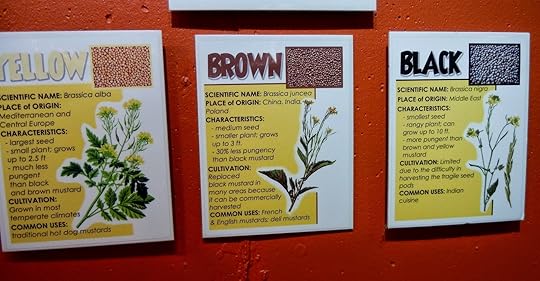 All along I wondered what the Bible was talking about when it said that the mustard seed was the smallest seed yet produced the largest plant. I happen to only be familiar with the yellow mustard plant. But look - the black mustard plant fits the bill perfectly.
All along I wondered what the Bible was talking about when it said that the mustard seed was the smallest seed yet produced the largest plant. I happen to only be familiar with the yellow mustard plant. But look - the black mustard plant fits the bill perfectly.

Which proves to me, once again, that the Bible is always right! Imagine that!
I blogged about the mustard seed once before, so am not going to elaborate. But I did discover something this weekend which I need to share to clarify the whole story about the mustard seed.

First of all, we have been to the Mustard Museum in the past, when it was in Mt Horeb. When we drove through there last spring, we were greatly dismayed to see that the building had been taken over by a women's clothing store or something. Totally unexpectedly, I discovered Friday night that the Museum had moved to Middleton, and as luck would have it we were spending the night just down the road in Madison.
So, on that dreary Saturday morning, I dragged the hubby there. And discovered this:
 All along I wondered what the Bible was talking about when it said that the mustard seed was the smallest seed yet produced the largest plant. I happen to only be familiar with the yellow mustard plant. But look - the black mustard plant fits the bill perfectly.
All along I wondered what the Bible was talking about when it said that the mustard seed was the smallest seed yet produced the largest plant. I happen to only be familiar with the yellow mustard plant. But look - the black mustard plant fits the bill perfectly.

Which proves to me, once again, that the Bible is always right! Imagine that!
Published on October 05, 2014 05:00
October 2, 2014
Streets of Hatchet Creek - Day 18
The other night, I shared a bunch of the scenic pictures from Frenchtown. Now I should back track and tell those of you who don’t know, just what Frenchtown is.
Highway 86, which is the route to the Paper Mill, runs through Frenchtown on the south side of town. When I was a kid that Paper Mill was the number one industry in town and the fathers of most of my friends worked there, including my dad of course.
I am sure that Frenchtown was named for the many French who lived in that area when the town was young. It is a known fact in my hometown that the founder of Tomahawk, William Bradley, didn’t like the French and wouldn’t sell land to them. Many of them would go to him and use a false name, an Americanized name which wouldn’t give away their ancestral roots, so that he would sell to them.
Here are just the random pictures I took the last two weeks of September.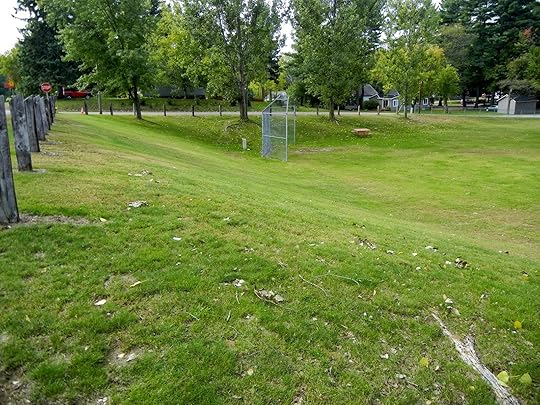 This is Frenchtown Park, more specifically, the sledding hill. Doesn't look like much now, but I will have to try to make it back when there is three feet of snow on the ground and this little hill is covered in kids.
This is Frenchtown Park, more specifically, the sledding hill. Doesn't look like much now, but I will have to try to make it back when there is three feet of snow on the ground and this little hill is covered in kids.
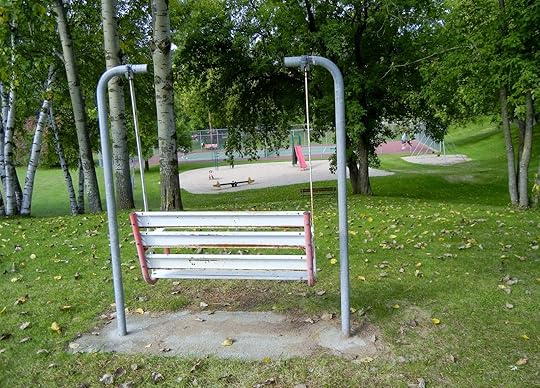 The less famous end of Frenchtown Park.
The less famous end of Frenchtown Park.
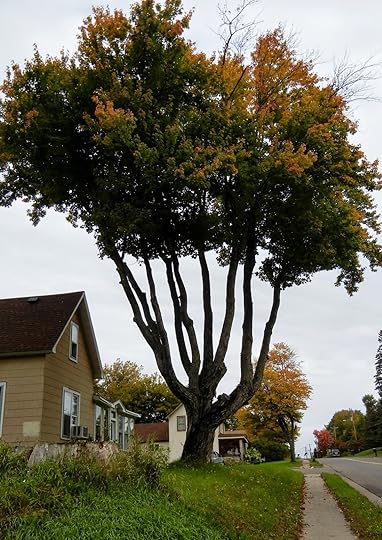 Just a tree along Tomahawk Avenue that I thought looked so cool.
Just a tree along Tomahawk Avenue that I thought looked so cool.
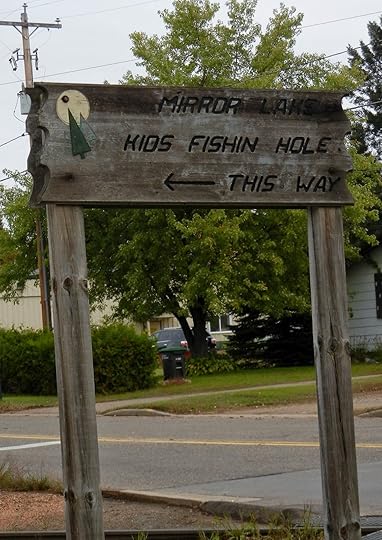 I hope some kids still fish on Mirror Lake.
I hope some kids still fish on Mirror Lake.
 And there it is.
And there it is.
 Don't know what this is. A trap for a really big critter, maybe?
Don't know what this is. A trap for a really big critter, maybe?
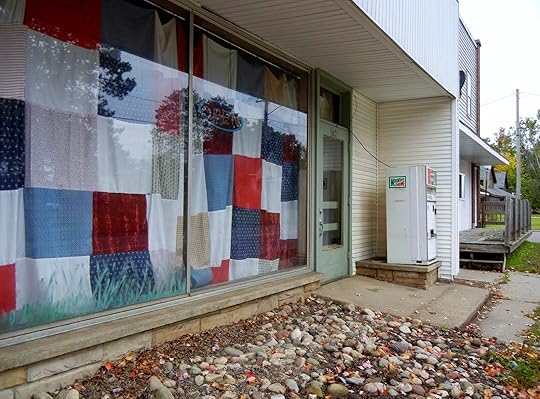 The sign on this store front said closed, but I kinda think it hasn't been opened in quite a while.
The sign on this store front said closed, but I kinda think it hasn't been opened in quite a while.
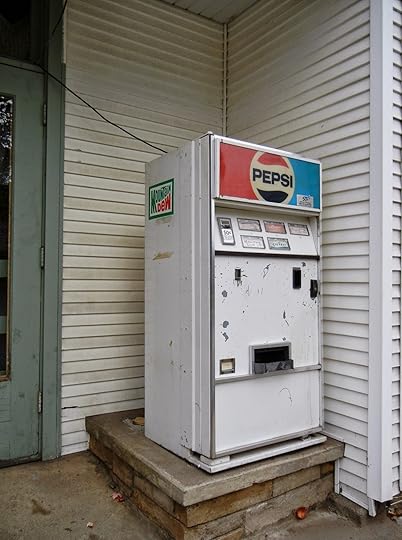 And does anyone know if this soda machine still works? I was afraid to even get close to it.
And does anyone know if this soda machine still works? I was afraid to even get close to it.
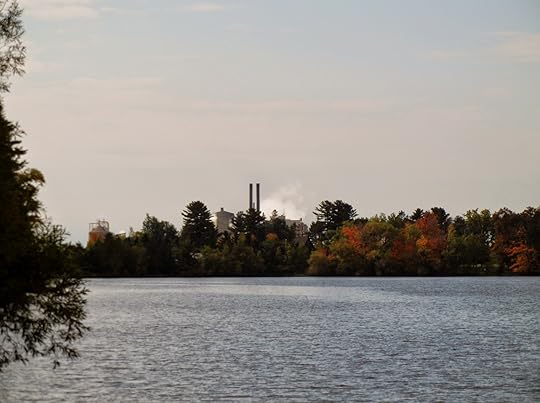 Aww, and I had to include one more picture of the Paper Mill.
Aww, and I had to include one more picture of the Paper Mill.
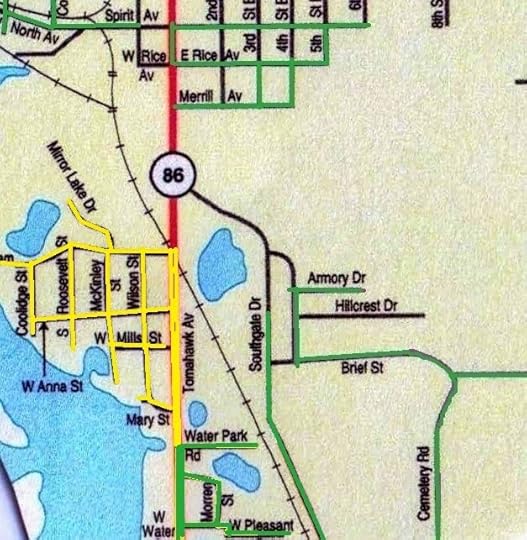 Those streets in yellow are what make up Frenchtown. I walked quite a few of them twice, just to get them all in. I think I would have covered better ground if I had carried a map, but I would be way too embarrassed to carry around a map of my own hometown.
Those streets in yellow are what make up Frenchtown. I walked quite a few of them twice, just to get them all in. I think I would have covered better ground if I had carried a map, but I would be way too embarrassed to carry around a map of my own hometown.
Highway 86, which is the route to the Paper Mill, runs through Frenchtown on the south side of town. When I was a kid that Paper Mill was the number one industry in town and the fathers of most of my friends worked there, including my dad of course.
I am sure that Frenchtown was named for the many French who lived in that area when the town was young. It is a known fact in my hometown that the founder of Tomahawk, William Bradley, didn’t like the French and wouldn’t sell land to them. Many of them would go to him and use a false name, an Americanized name which wouldn’t give away their ancestral roots, so that he would sell to them.
Here are just the random pictures I took the last two weeks of September.
 This is Frenchtown Park, more specifically, the sledding hill. Doesn't look like much now, but I will have to try to make it back when there is three feet of snow on the ground and this little hill is covered in kids.
This is Frenchtown Park, more specifically, the sledding hill. Doesn't look like much now, but I will have to try to make it back when there is three feet of snow on the ground and this little hill is covered in kids. The less famous end of Frenchtown Park.
The less famous end of Frenchtown Park. Just a tree along Tomahawk Avenue that I thought looked so cool.
Just a tree along Tomahawk Avenue that I thought looked so cool. I hope some kids still fish on Mirror Lake.
I hope some kids still fish on Mirror Lake. And there it is.
And there it is. Don't know what this is. A trap for a really big critter, maybe?
Don't know what this is. A trap for a really big critter, maybe? The sign on this store front said closed, but I kinda think it hasn't been opened in quite a while.
The sign on this store front said closed, but I kinda think it hasn't been opened in quite a while. And does anyone know if this soda machine still works? I was afraid to even get close to it.
And does anyone know if this soda machine still works? I was afraid to even get close to it. Aww, and I had to include one more picture of the Paper Mill.
Aww, and I had to include one more picture of the Paper Mill. Those streets in yellow are what make up Frenchtown. I walked quite a few of them twice, just to get them all in. I think I would have covered better ground if I had carried a map, but I would be way too embarrassed to carry around a map of my own hometown.
Those streets in yellow are what make up Frenchtown. I walked quite a few of them twice, just to get them all in. I think I would have covered better ground if I had carried a map, but I would be way too embarrassed to carry around a map of my own hometown.
Published on October 02, 2014 18:49
September 30, 2014
Streets of Hatchet Creek, Day 17
It seems like a long time since I have blogged about the streets of my hometown. I’ve walked the same neighborhood twice in the last few weeks, so I think that I will have to blog about it twice.
Frenchtown, on the south side of town, is full of beautiful scenery, especially in the fall. Amazing the difference one week makes. And now, one more week later, a lot of the leaves are down already. I think I hit it just about right.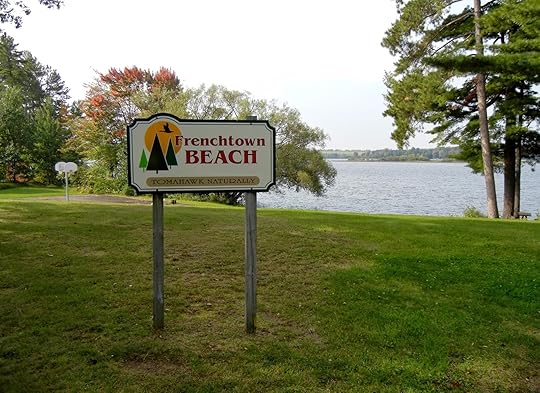 September 19
September 19
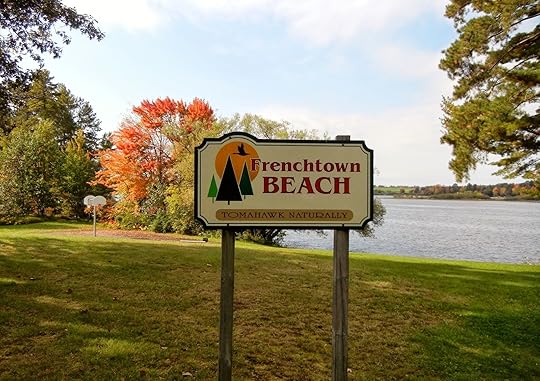 September 25
September 25
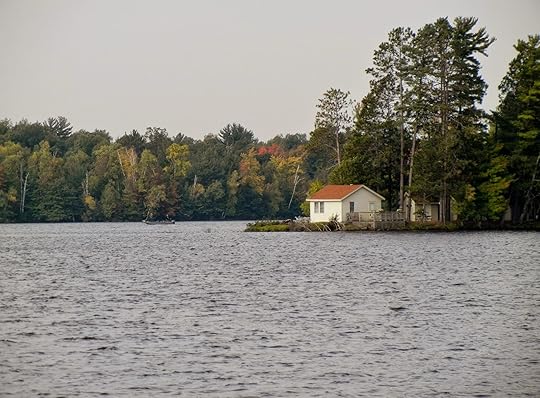 September 19
September 19
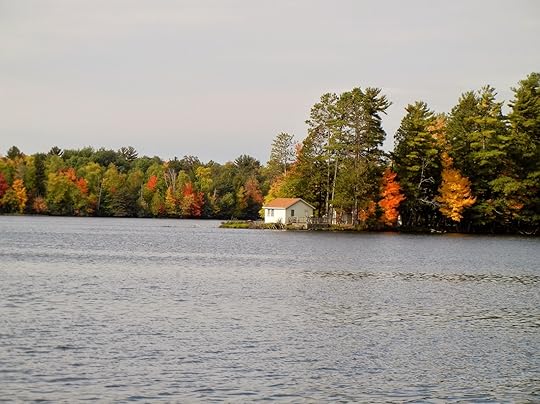 September 25
September 25
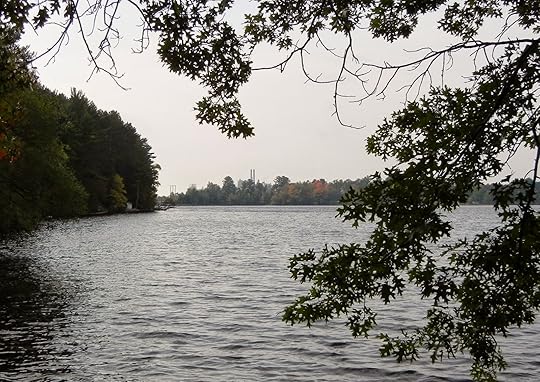 September 19
September 19
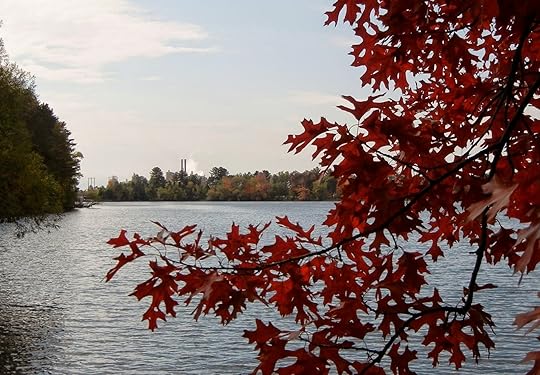 September 25
September 25
 And then I veered off down one of the trails from Frenchtown into Bradley Park.
And then I veered off down one of the trails from Frenchtown into Bradley Park.
 The changing leaves are so fascinating.
The changing leaves are so fascinating.
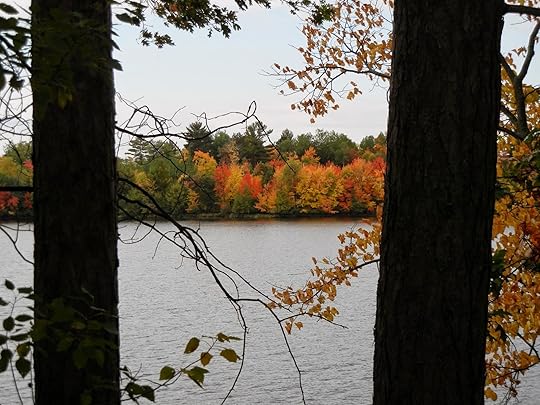 And anytime you add a body of water to the fall color -
And anytime you add a body of water to the fall color -
 - it is totally awesome. What a beautiful town I am blessed to live in.
- it is totally awesome. What a beautiful town I am blessed to live in.
Frenchtown, on the south side of town, is full of beautiful scenery, especially in the fall. Amazing the difference one week makes. And now, one more week later, a lot of the leaves are down already. I think I hit it just about right.
 September 19
September 19
 September 25
September 25
 September 19
September 19
 September 25
September 25
 September 19
September 19
 September 25
September 25
 And then I veered off down one of the trails from Frenchtown into Bradley Park.
And then I veered off down one of the trails from Frenchtown into Bradley Park.
 The changing leaves are so fascinating.
The changing leaves are so fascinating.
 And anytime you add a body of water to the fall color -
And anytime you add a body of water to the fall color -
 - it is totally awesome. What a beautiful town I am blessed to live in.
- it is totally awesome. What a beautiful town I am blessed to live in.
Published on September 30, 2014 19:03
September 28, 2014
You Can Thrive
Can papyrus grow tall where there is no marsh? Can reeds thrive without water? (Job 8:11 New International Version)
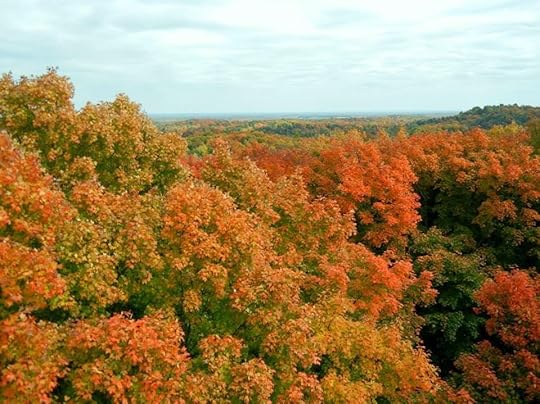 Jamming to the Christian radio station yesterday on my drive to Wausau to see my daughter, I sang along to one of my favorite songs. “Redeemed” by Big Daddy Weave. I’ve written about it here before.
Jamming to the Christian radio station yesterday on my drive to Wausau to see my daughter, I sang along to one of my favorite songs. “Redeemed” by Big Daddy Weave. I’ve written about it here before.
As the end of the song approached and I was enjoying the music as much as I was enjoying the breathtaking autumn vistas along the road, I thought, “God, it would be so cool if that newer song that I really like came on next.”
We know we were made for so much more than ordinary livesIt's time for us to do more than just surviveWe were made to thrive(from Thrive by Casting Crowns, January 28, 2014)
Didn’t take long for the tears to start running down my face. We have such a big God and yet He is willing to crawl in my car to satisfy my tiniest whim.
The cool thing about this song is that it always reminds me of the mission statement my daughter came up with for our nonprofit organization. The mission of Tumaini Volunteers is to assist developing communities in Kenya to thrive by providing sustainable projects to help make them self-sufficient.
Sure, we can all survive. The people living in poverty in Kenya can survive. But don’t we all want to thrive? Don’t we want everyone we meet to thrive as well? And whenever I think of my beautiful daughter, I’m reminded that she is living anything but an ordinary life. God has certainly blessed us.
Lord, God, Heavenly Father, I thank You from the very bottom of my heart, I thank You even from the bottom of my feet. You are such an amazing God. I have never done anything to deserve all that You have rained down upon me. Help me to take my ordinary life and share some of what I have with others. In Jesus name, Amen
 Jamming to the Christian radio station yesterday on my drive to Wausau to see my daughter, I sang along to one of my favorite songs. “Redeemed” by Big Daddy Weave. I’ve written about it here before.
Jamming to the Christian radio station yesterday on my drive to Wausau to see my daughter, I sang along to one of my favorite songs. “Redeemed” by Big Daddy Weave. I’ve written about it here before. As the end of the song approached and I was enjoying the music as much as I was enjoying the breathtaking autumn vistas along the road, I thought, “God, it would be so cool if that newer song that I really like came on next.”
We know we were made for so much more than ordinary livesIt's time for us to do more than just surviveWe were made to thrive(from Thrive by Casting Crowns, January 28, 2014)
Didn’t take long for the tears to start running down my face. We have such a big God and yet He is willing to crawl in my car to satisfy my tiniest whim.
The cool thing about this song is that it always reminds me of the mission statement my daughter came up with for our nonprofit organization. The mission of Tumaini Volunteers is to assist developing communities in Kenya to thrive by providing sustainable projects to help make them self-sufficient.
Sure, we can all survive. The people living in poverty in Kenya can survive. But don’t we all want to thrive? Don’t we want everyone we meet to thrive as well? And whenever I think of my beautiful daughter, I’m reminded that she is living anything but an ordinary life. God has certainly blessed us.
Lord, God, Heavenly Father, I thank You from the very bottom of my heart, I thank You even from the bottom of my feet. You are such an amazing God. I have never done anything to deserve all that You have rained down upon me. Help me to take my ordinary life and share some of what I have with others. In Jesus name, Amen
Published on September 28, 2014 05:18
September 24, 2014
Look to the Phoenix
There has been much lamenting in my hometown the last six months or so. And I have been right there, in the trenches, documenting it all, taking and saving 150 pictures (I deleted at least another 150) since last March. Watching our old hospital, sitting vacant for eleven years, meeting its final end.
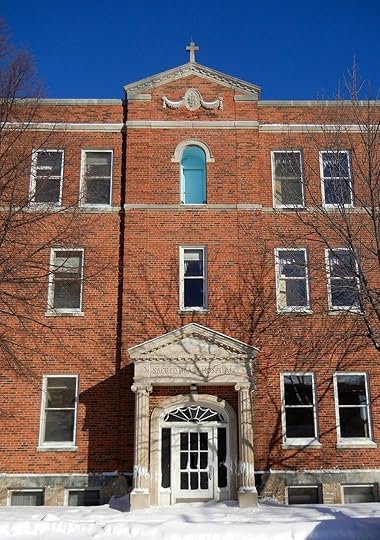 This is the original entrance to the oldest section of the hospital. I took this picture in February 2013, a year before the final fate of the building was decided.
This is the original entrance to the oldest section of the hospital. I took this picture in February 2013, a year before the final fate of the building was decided.
 July 11, 2014
July 11, 2014
 September 14, 2014
September 14, 2014
 September 17, 2014
September 17, 2014
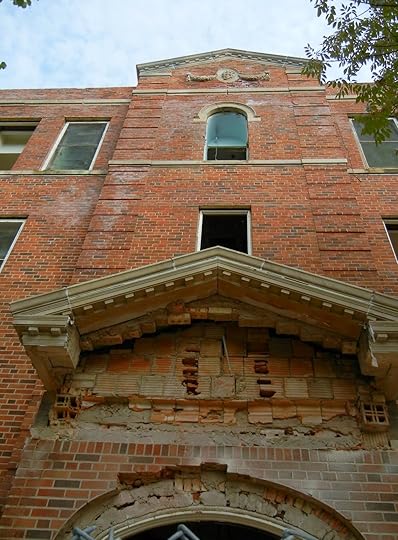 September 19, 2014
September 19, 2014
 September 23, 2014
September 23, 2014
I’d like to believe though, that just like the phoenix, something good will rise from this rubble, that the assisted living facility they plan to build on this lot will serve our community as well as the old hospital had for so many years.
When I was at the site a week ago, I had further confirmation that this was not an entire waste. I happened to pull up to the building as these two sisters were hard at work, salvaging what they could from the oldest part of the hospital.
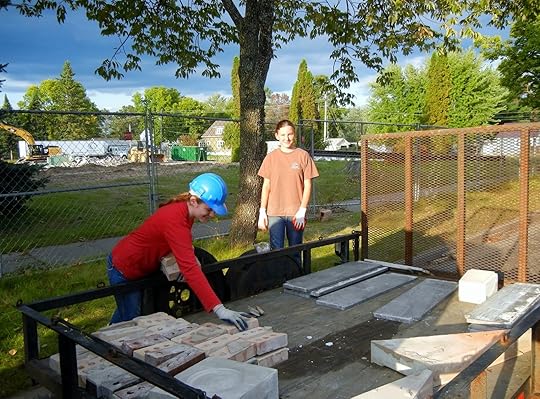
One of them plans to use this as their project for their Gold Award in Girl Scouting (comparable to the Boy Scout’s Eagle Scout), using old pieces of this doorway and marble from the window sills, to be incorporated into a memorial garden at the location of the new Sacred Heart Hospital.


I would say that I am far from done taking pictures. I promise to keep you posted.
 This is the original entrance to the oldest section of the hospital. I took this picture in February 2013, a year before the final fate of the building was decided.
This is the original entrance to the oldest section of the hospital. I took this picture in February 2013, a year before the final fate of the building was decided.
 July 11, 2014
July 11, 2014
 September 14, 2014
September 14, 2014
 September 17, 2014
September 17, 2014
 September 19, 2014
September 19, 2014
 September 23, 2014
September 23, 2014I’d like to believe though, that just like the phoenix, something good will rise from this rubble, that the assisted living facility they plan to build on this lot will serve our community as well as the old hospital had for so many years.
When I was at the site a week ago, I had further confirmation that this was not an entire waste. I happened to pull up to the building as these two sisters were hard at work, salvaging what they could from the oldest part of the hospital.

One of them plans to use this as their project for their Gold Award in Girl Scouting (comparable to the Boy Scout’s Eagle Scout), using old pieces of this doorway and marble from the window sills, to be incorporated into a memorial garden at the location of the new Sacred Heart Hospital.


I would say that I am far from done taking pictures. I promise to keep you posted.
Published on September 24, 2014 18:36
September 22, 2014
A 24-year love affair
In the spring of 1990, my first husband and I were halfheartedly looking for a house to buy. Driving random roads around town, we watched for houses with for sale signs in the front yards, wondering if we could afford any of them. We stopped at the end of a driveway with just such a sign. The house wasn't visible from the road, so Daniel eased the car into the driveway. I immediately fell in love with what I saw. Then told him to back out quickly; there was no way we could afford it.
A few days later, while at work, Daniel started talking to a man who had a house for sale. As the man went on, it dawned on Daniel which house he was talking about. It had been on the market for a while and was not far over our budget.
Though it only had two bedrooms, this was the house I wanted. Nick was four and Val had just been born; they could share a room for a while but not forever.
We moved in twenty-four years ago today. And I’m still in love with it. The view when you first turn up the driveway. A lot has changed over the years, but this is the spot where I fell in love.
The view when you first turn up the driveway. A lot has changed over the years, but this is the spot where I fell in love.
 Front of the house; moving day, September 22, 1990
Front of the house; moving day, September 22, 1990
 Back of the house, September 22, 1990
Back of the house, September 22, 1990
 A few months after the addition which gained us that third bedroom, September 22, 1999. On the right is Shadow one of our Cocker spaniels who died in 2007.
A few months after the addition which gained us that third bedroom, September 22, 1999. On the right is Shadow one of our Cocker spaniels who died in 2007.
 Back yard after the garage became the living room. We have a clothes line too. September 22, 1999
Back yard after the garage became the living room. We have a clothes line too. September 22, 1999
 And here we are in September 2014. Another dog in the yard, Dino, of course.
And here we are in September 2014. Another dog in the yard, Dino, of course.
 Back yard, September 2014. We have had the deck for quite a few years. A new roof two years ago. Himey is currently painting the house, so I can't guarantee these are the last pictures you will see.
Back yard, September 2014. We have had the deck for quite a few years. A new roof two years ago. Himey is currently painting the house, so I can't guarantee these are the last pictures you will see.
A few days later, while at work, Daniel started talking to a man who had a house for sale. As the man went on, it dawned on Daniel which house he was talking about. It had been on the market for a while and was not far over our budget.
Though it only had two bedrooms, this was the house I wanted. Nick was four and Val had just been born; they could share a room for a while but not forever.
We moved in twenty-four years ago today. And I’m still in love with it.
 The view when you first turn up the driveway. A lot has changed over the years, but this is the spot where I fell in love.
The view when you first turn up the driveway. A lot has changed over the years, but this is the spot where I fell in love.  Front of the house; moving day, September 22, 1990
Front of the house; moving day, September 22, 1990
 Back of the house, September 22, 1990
Back of the house, September 22, 1990
 A few months after the addition which gained us that third bedroom, September 22, 1999. On the right is Shadow one of our Cocker spaniels who died in 2007.
A few months after the addition which gained us that third bedroom, September 22, 1999. On the right is Shadow one of our Cocker spaniels who died in 2007.
 Back yard after the garage became the living room. We have a clothes line too. September 22, 1999
Back yard after the garage became the living room. We have a clothes line too. September 22, 1999
 And here we are in September 2014. Another dog in the yard, Dino, of course.
And here we are in September 2014. Another dog in the yard, Dino, of course.
 Back yard, September 2014. We have had the deck for quite a few years. A new roof two years ago. Himey is currently painting the house, so I can't guarantee these are the last pictures you will see.
Back yard, September 2014. We have had the deck for quite a few years. A new roof two years ago. Himey is currently painting the house, so I can't guarantee these are the last pictures you will see.
Published on September 22, 2014 18:30
September 21, 2014
Patterns in the World
Do not conform to the pattern of this world, but be transformed by the renewing of your mind. Then you will be able to test and approve what God’s will is—his good, pleasing and perfect will. Romans 12:2 New International Version (NIV)
I won this quilt in a raffle for the Relay for Life a few years ago. Naturally it is too pretty to use, so I hung it on my bedroom wall. Someone spent many hours on this, laying all the pieces out so that once the quilt was sewn, it would display this pretty pattern.
When I was in co-worker’s office the other day, I told her how beautiful this quilt was on her wall. She said that it was her favorite and that she didn’t have a pattern for it when she started.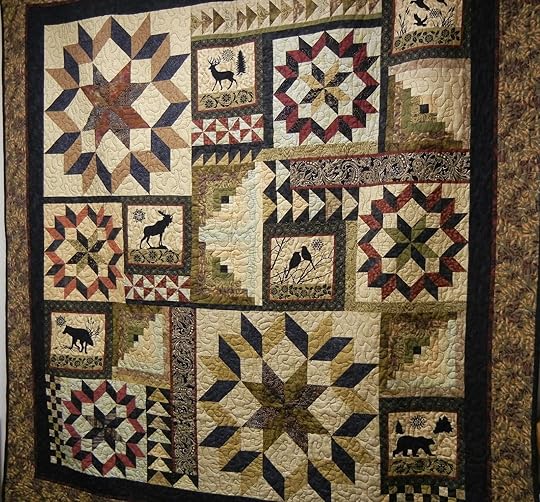 She explained the whole process she went through, starting with the wildlife scenes and then adding to it. Running out and buying more material when she didn’t have anything that worked in a certain block.
She explained the whole process she went through, starting with the wildlife scenes and then adding to it. Running out and buying more material when she didn’t have anything that worked in a certain block.


I already had this quilting blog spinning around in my mind when I went to church last night. It is that time of year where the ladies spread out the quilts they have made for world relief. In a few weeks, their hard-work will be packed up and shipped to those in need in third world countries.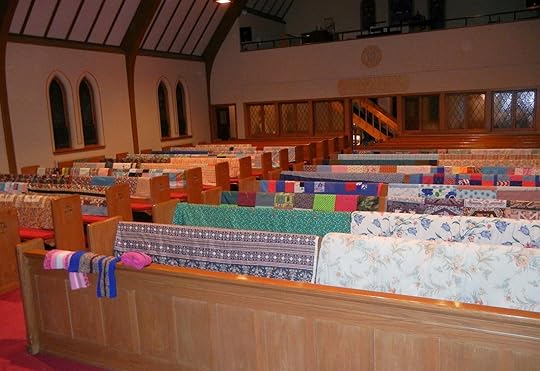 And my own quilting? Well, this is how good it is going - I couldn’t find the quilt pieces I started working on years ago.
And my own quilting? Well, this is how good it is going - I couldn’t find the quilt pieces I started working on years ago.
So, what does this all have to do with anything? Sometimes we work with a pattern, sometimes we work by the seat of our pants. We work with what we have, but when we are hard up, we run to the store and buy what we need. The outcome is never the same. each finished product is a one-of-a-kind, each ends up somewhere else. And in my case, there may not be an outcome yet for many years, but that doesn’t mean I am a failure, I just am on a different schedule.
Which is how we should live our lives. Sometimes things go as planned, sometimes they don’t. Sometimes we have what we need, sometimes we don’t. But in the end all things work out according to God’s plan.
I won this quilt in a raffle for the Relay for Life a few years ago. Naturally it is too pretty to use, so I hung it on my bedroom wall. Someone spent many hours on this, laying all the pieces out so that once the quilt was sewn, it would display this pretty pattern.

When I was in co-worker’s office the other day, I told her how beautiful this quilt was on her wall. She said that it was her favorite and that she didn’t have a pattern for it when she started.
 She explained the whole process she went through, starting with the wildlife scenes and then adding to it. Running out and buying more material when she didn’t have anything that worked in a certain block.
She explained the whole process she went through, starting with the wildlife scenes and then adding to it. Running out and buying more material when she didn’t have anything that worked in a certain block.


I already had this quilting blog spinning around in my mind when I went to church last night. It is that time of year where the ladies spread out the quilts they have made for world relief. In a few weeks, their hard-work will be packed up and shipped to those in need in third world countries.
 And my own quilting? Well, this is how good it is going - I couldn’t find the quilt pieces I started working on years ago.
And my own quilting? Well, this is how good it is going - I couldn’t find the quilt pieces I started working on years ago.So, what does this all have to do with anything? Sometimes we work with a pattern, sometimes we work by the seat of our pants. We work with what we have, but when we are hard up, we run to the store and buy what we need. The outcome is never the same. each finished product is a one-of-a-kind, each ends up somewhere else. And in my case, there may not be an outcome yet for many years, but that doesn’t mean I am a failure, I just am on a different schedule.
Which is how we should live our lives. Sometimes things go as planned, sometimes they don’t. Sometimes we have what we need, sometimes we don’t. But in the end all things work out according to God’s plan.
Published on September 21, 2014 05:26
September 18, 2014
How's your health?
Tonight I completed my online health assessment for our health insurance. I’ve been fighting doing it for years, and if I told you why you would say that it’s not my physical health that is an issue, but my mental health. So we won’t discuss that.
I’ve worked in the medical field for over 27 years. It’s not like I really need a computer-generated program to tell me what my health concerns are. But if they really send me a check for $150 for doing this assessment, in addition to completing my biometrics screen, well, I guess I’ll take the money.
I don’t drink alcohol. I don’t smoke. My total cholesterol is 168, my fasting blood sugar 93. My BMI is 24 (depending on which chart you use, that can be borderline overweight, but our health insurance congratulated me on it, so they must think it’s ok). My blood pressure was 112/68 (or something close to that. I’m not going to drag it out again).
I don’t eat beef. They asked if I ever eat lamb. I don’t know if that is good for you or not, but on principle I avoid eating all baby animals. I do eat processed meats once or twice a week (hard telling what adult or baby animals are in there). I fudged the rest of my diet by a little bit. I think about eating fruits and vegetables, I want to eat them, but somehow they rarely find their way into my bag in the morning.
They didn’t ask about chocolate, though. Probably a good thing.
They did ask about sleep. That is probably my biggest health risk. I need more sleep, but there are just not enough hours in the day. Which leads to the next question. Stress. I must have really fudged those answers. Otherwise lights would have started blinking on the computer screen, words flashing across the screen: “We have called 911 for you. Please stay where you are and the ambulance will be there shortly.”
The only other concern this computer-generated questionnaire had was that I am not active enough. Which we all know is not true, but I think they define exercise as a sustained yet somewhat relaxing activity that raises your heart rate but gets you in a zen-kind of a place. Instead of activity which only raises your blood pressure and your stress level.
So I told the computer program that I would put a reasonable amount of effort into getting the proper amount and type of exercise and I would at least think about getting more sleep. Life is too short to live forever.
Oh, and I got my flu shot today.
How are your biometrics scores? How long will your life be?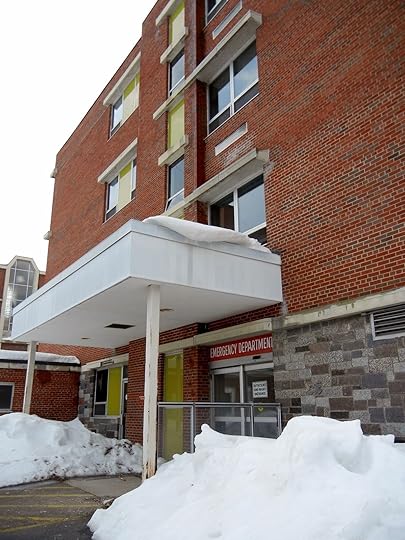 You want to avoid this place.
You want to avoid this place.
 And this place.
And this place.
I’ve worked in the medical field for over 27 years. It’s not like I really need a computer-generated program to tell me what my health concerns are. But if they really send me a check for $150 for doing this assessment, in addition to completing my biometrics screen, well, I guess I’ll take the money.
I don’t drink alcohol. I don’t smoke. My total cholesterol is 168, my fasting blood sugar 93. My BMI is 24 (depending on which chart you use, that can be borderline overweight, but our health insurance congratulated me on it, so they must think it’s ok). My blood pressure was 112/68 (or something close to that. I’m not going to drag it out again).
I don’t eat beef. They asked if I ever eat lamb. I don’t know if that is good for you or not, but on principle I avoid eating all baby animals. I do eat processed meats once or twice a week (hard telling what adult or baby animals are in there). I fudged the rest of my diet by a little bit. I think about eating fruits and vegetables, I want to eat them, but somehow they rarely find their way into my bag in the morning.
They didn’t ask about chocolate, though. Probably a good thing.
They did ask about sleep. That is probably my biggest health risk. I need more sleep, but there are just not enough hours in the day. Which leads to the next question. Stress. I must have really fudged those answers. Otherwise lights would have started blinking on the computer screen, words flashing across the screen: “We have called 911 for you. Please stay where you are and the ambulance will be there shortly.”
The only other concern this computer-generated questionnaire had was that I am not active enough. Which we all know is not true, but I think they define exercise as a sustained yet somewhat relaxing activity that raises your heart rate but gets you in a zen-kind of a place. Instead of activity which only raises your blood pressure and your stress level.
So I told the computer program that I would put a reasonable amount of effort into getting the proper amount and type of exercise and I would at least think about getting more sleep. Life is too short to live forever.
Oh, and I got my flu shot today.
How are your biometrics scores? How long will your life be?
 You want to avoid this place.
You want to avoid this place. And this place.
And this place.
Published on September 18, 2014 19:31
September 15, 2014
Streets of Hatchet Creek - Day 16
This past weekend was the big Fall Ride, when 50,000 Harleys rumble into town. Ok, I don’t know if there have ever been that many, but this year, I suspect, thanks to the weather, that number was really down. Sunday night, when I walked the main drag, west on Somo Avenue and back east up Wisconsin Ave, you surely never would have guessed that even twenty-five motorcycles had been in town. Things dry up pretty quickly in small-town America.
Here are some panoramics from my walk.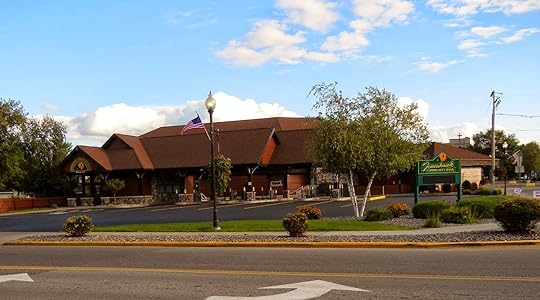
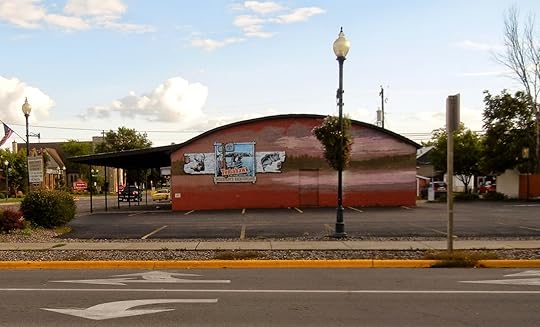
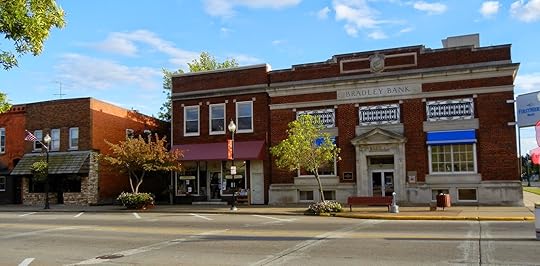
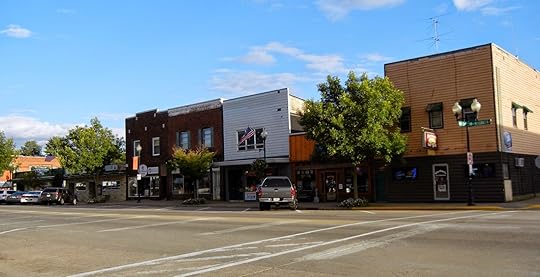
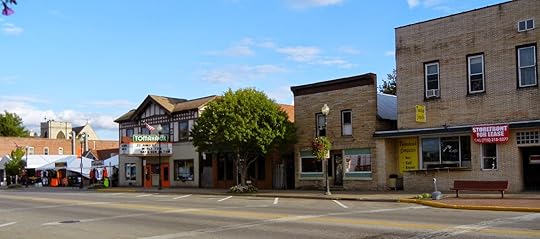 I guess we don’t have to welcome the bikers anymore, just pray they all got home safely.
I guess we don’t have to welcome the bikers anymore, just pray they all got home safely.
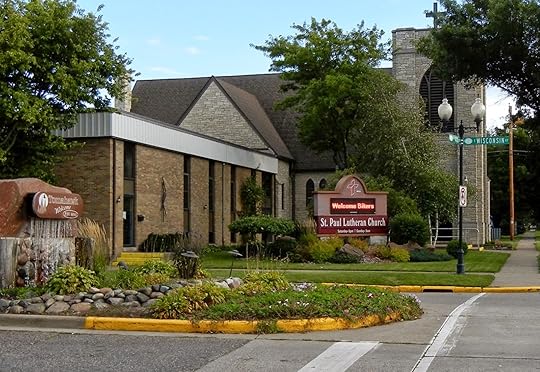 All the Harley merchandise has been packed up.
All the Harley merchandise has been packed up.
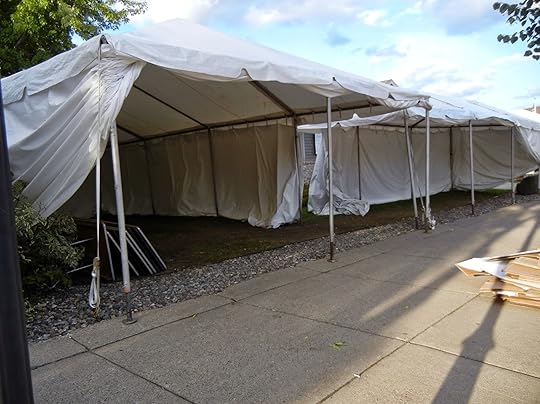 And there won’t be too much rumble for another year.
And there won’t be too much rumble for another year.

On my way back to where I had parked the car. I sure couldn’t figure out the tiger.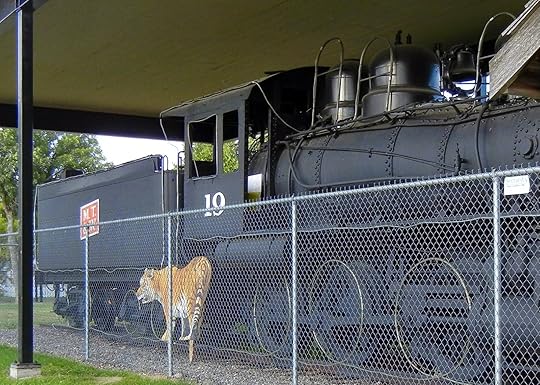
Here are some panoramics from my walk.




 I guess we don’t have to welcome the bikers anymore, just pray they all got home safely.
I guess we don’t have to welcome the bikers anymore, just pray they all got home safely.  All the Harley merchandise has been packed up.
All the Harley merchandise has been packed up. And there won’t be too much rumble for another year.
And there won’t be too much rumble for another year.
On my way back to where I had parked the car. I sure couldn’t figure out the tiger.

Published on September 15, 2014 19:02



